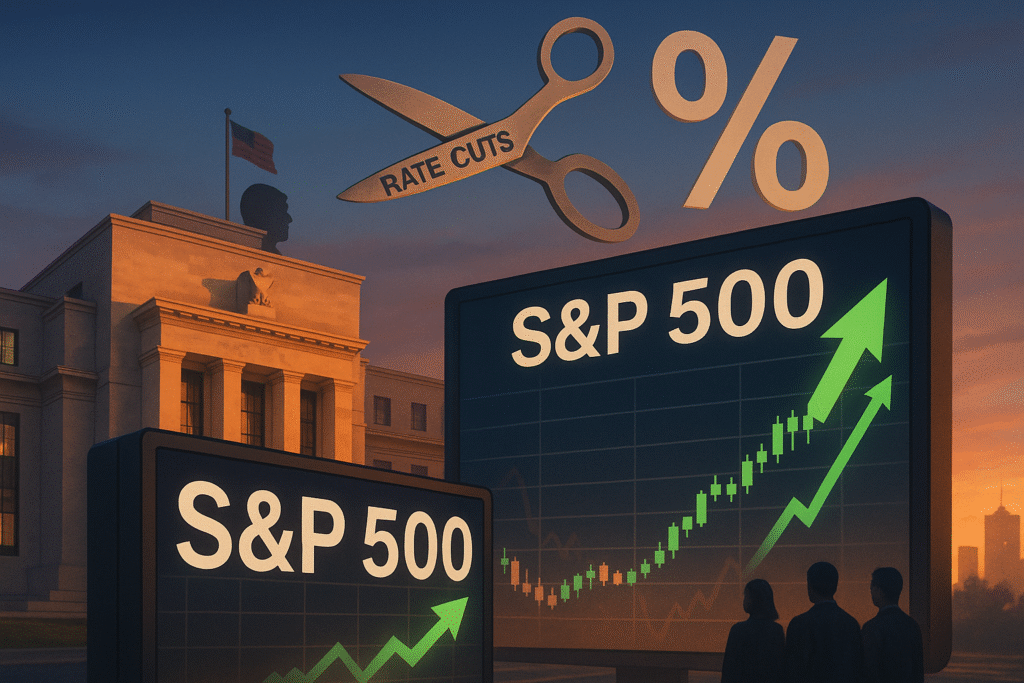When Federal Reserve Chair Jerome Powell signaled the possibility of two summer rate cuts at the May 2025 press briefing, traders wasted no time. Futures priced in a 50 bp easing by August, the dollar weakened, and the S&P 500 rate cuts narrative charged into mainstream headlines. Within hours, the benchmark closed at an all-time high of 5,430, capping a 9 % year-to-date gain and igniting debate over whether cheaper money can offset already-rich valuations.

S&P 500 rate cuts – A Catalyst or a Culprit?
The last full-percentage-point easing cycle in 2019 drove the index’s forward P/E from 16× to 19×. Today, the multiple already sits near 22×, its loftiest mark since late-2021. Bulls argue that lower yields raise the present value of future cash flows, justifying higher multiples. Bears counter that the S&P 500 rate cuts story merely props up an earnings base that still faces margin pressure from wage inflation and lingering supply-chain frictions.
Key data point: the equity risk premium stands at 3.7 %, a hair above the post-GFC average of 3.6 %. A pair of 25 bp Fed cuts would lower the 10-year Treasury yield toward 4 %, pushing the premium back above 4 %—a level last seen during the October 2024 correction. That extra cushion might keep allocators from trimming U.S. equity exposure despite valuation fatigue.
Valuation Math Beyond the S&P 500 rate cuts Narrative
Earnings, not policy alone, sustain long-term price moves. Consensus now calls for 10 % EPS growth in 2025, up from 7 % pre-Fed-hint. The jump stems from three forces:
- Lower Interest Expense: Investment-grade corporates issued $280 billion in fixed-rate debt during Q1, locking in cheaper coupons ahead of any cut.
- Multiple Expansion in Mega-Caps: Apple, Microsoft, and Alphabet together account for 18 % of index weight; their blended forward P/E rose two turns in a week.
- Financial Sector Relief: Banks climbed 6 % after Powell’s remarks, as lower funding costs can offset compressed lending margins.
Yet a thought experiment reveals limits. Even if the P/E reaches 23×, the index would trade near 5,700—only 5 % above today’s level—unless earnings also surprise to the upside. That suggests policy relief has less room to boost valuations than in prior cycles.
Sector Winners and Laggards in a S&P 500 rate cuts World
Technology leads because discounted cash-flow models are hypersensitive to small changes in the discount rate. Semi-conductors have lagged software in raw performance, but their EPS growth could rebound if AI-capex cycles persist into 2026.
Financials enjoy funding-cost relief, yet investors must watch net-interest-margin guidance. If long yields fall faster than short rates, yield-curve steepness could narrow, hurting bank profitability.
Utilities and REITs—classic rate-sensitive plays—should benefit, but they now trade at 19× forward P/E, limiting upside.
Energy is the wild card. Lower U.S. yields often weaken the dollar, supporting crude prices; however, the sector’s weighting has already ticked higher after Saudi Aramco’s MSCI World inclusion, so the absolute boost to index points may be modest.
What Could Derail the S&P 500’s Momentum?
- Sticky Core Inflation: If shelter and services CPI fail to fall, the Fed’s “two cuts” morph into “one and done.”
- Fiscal Cliff Risks: Negotiations on the 2026 budget begin this autumn; a drawn-out battle may heighten volatility and widen credit spreads.
- Earnings Misses: Big Tech’s lofty multiples leave little room for disappointment. A single guidance cut could shave 50-100 points from the index.
- Global Growth Shocks: China’s uneven recovery and Europe’s tepid expansion keep export-heavy sectors vulnerable.
Portfolio Playbook for the rate-cut rally
- Duration Barbell: Pair long-duration tech with short-cycle industrials to hedge macro swings.
- Selective Financials: Focus on fee-income banks and insurers less exposed to margin compression.
- Covered Calls: With the VIX at 14, implied vol is low but selling out-of-the-money calls on mega-caps can harvest premium without sacrificing core exposure.
- Quality Tilt: Companies boasting high free-cash-flow yield and pricing power can withstand any half-step by the Fed.
Final Word: Can Rate Relief Offset Valuation Strain?
History suggests that a mild easing cycle can extend bull markets, but only if earnings keep pace. The S&P 500 rate cuts episode will shine in hindsight if corporate profits grow into their valuations. Should inflation linger or earnings stall, today’s record closes could mark an interim top. Investors should embrace tactical wins from policy relief while staying ready for surprises—because in markets, relief rallies can turn on a dime.